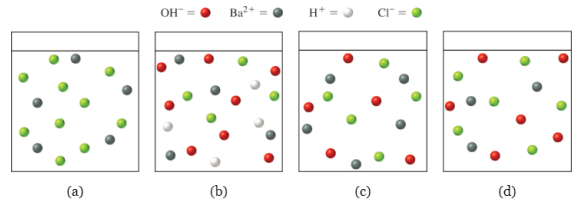
Concept explainers
Which of the following is the correct net ionic equation for the reaction of
Use the following diagrams to answer Checkpoint questions 4.3.5 and 4.3.6.

Want to see the full answer?
Check out a sample textbook solution
Chapter 4 Solutions
Chemistry
Additional Science Textbook Solutions
Organic Chemistry (9th Edition)
Chemistry
Inorganic Chemistry
Organic Chemistry As a Second Language: Second Semester Topics
Chemistry & Chemical Reactivity
Chemistry by OpenStax (2015-05-04)
- 3.85 The particulate drawing shown represents an aqueous so- lution of an acid HA, where A might represent an atom or group of atoms. Is HA a strong acid or a weak acid? Explain how you can tell from the picture.arrow_forwardWrite molecular and net ionic equations for the successive neutralizations of each acidic hydrogen of sulfurous acid by aqueous calcium hydroxide. CaSO3 is insoluble; the acid salt is soluble.arrow_forwardWrite a net ionic equation for any precipitation reaction that occurs when 1 M solutions of the following are mixed. (a) copper(II) sulfate and sodium chloride (b) manganese(II) nitrate and ammonium hydroxide (c) silver nitrate and hydrochloric acid (d) nickel(II) sulfate and potassium hydroxide (e) ammonium carbonate and sodium nitratearrow_forward
- Give an example of a polyprotic acid and write equations for the successive neutralizations of the acidic hydrogen atoms of the acid molecule to produce a series of salts.arrow_forwardWhat is the net ionic equation for the reaction of acetic acid and sodium hydroxide? (a) H3O+(aq) + OH(aq) 2 H2O(l) (b) Na+(aq) + CH3CO2(aq) NaCH3CO2(aq) (c) CH3CO2H(aq) + OH(aq) H2O(l) + CH3CO2(aq) (d) CH3CO2H(aq) + NaOH(aq) H2O(l) NaCH3CO2(aq)arrow_forwardVitamin C has the formula C6H8O6. Besides being an acid, it is a reducing agent. One method for determining the amount of vitamin C in a sample is to titrate it with a solution of bromine, Br2, an oxidizing agent. C6H8O6(aq) + Br2(aq) 2 HBr(aq) + C6H6O6(aq) A 1.00-g "chewable" vitamin C tablet requires 27.85 ml of 0.102 M Br2 for titration to the equivalence point. What is the mass of vitamin C in the tablet?arrow_forward
- Complete and balance each of the following molecular equations (in aqueous solution); include phase labels. Then, for each, write the net ionic equation. a NaOH + HNO3 b HCl + Ba(OH)2 c HC2H3O2 + Ca(OH)2 d NH3 + HNO3arrow_forwardssume a highly magnified view of a solution of HCI that allows you to “see” the HCl. Draw this magnified view. If you dropped in a piece of magnesium, the magnesium would disappear, and hydrogen gas would he released. Represent this change using symbols for the elements, and write the balanced equation.arrow_forwardOranges and grapefruits are known as citrus fruits because their acidity comes mainly from citric acid, H3C6H5O7. Calculate the concentration of citric acid in a solution if a 30.00-mL sample is neutralized by 15.10 mL of 0.0100 M KOH. Assume that three acidic hydrogens of each citric acid molecule are neutralized in the reaction.arrow_forward
- Complete and balance each of the following molecular equations (in aqueous solution); include phase labels. Then, for each, write the net ionic equation. a Al(OH)3 + HCl b HClO + Sr(OH)2 c Ba(OH)2 + HC2H3O2 d H2SO4 + KOHarrow_forwardFollow the directions of Question 7 for solutions of the following: (a) silver nitrate and sodium chloride (b) cobalt(II) nitrate and sodium hydroxide (c) ammonium phosphate and potassium hydroxide (d) copper(II) sulfate and sodium carbonate (e) lithium sulfate and barium hydroxidearrow_forwardWhat is the molar concentration of an H2SO4 solution if a 50.0-mL sample requires 9.65 mL of a 1.33 M solution of NaOH to reach the equivalence point?arrow_forward
 ChemistryChemistryISBN:9781305957404Author:Steven S. Zumdahl, Susan A. Zumdahl, Donald J. DeCostePublisher:Cengage Learning
ChemistryChemistryISBN:9781305957404Author:Steven S. Zumdahl, Susan A. Zumdahl, Donald J. DeCostePublisher:Cengage Learning
 General Chemistry - Standalone book (MindTap Cour...ChemistryISBN:9781305580343Author:Steven D. Gammon, Ebbing, Darrell Ebbing, Steven D., Darrell; Gammon, Darrell Ebbing; Steven D. Gammon, Darrell D.; Gammon, Ebbing; Steven D. Gammon; DarrellPublisher:Cengage Learning
General Chemistry - Standalone book (MindTap Cour...ChemistryISBN:9781305580343Author:Steven D. Gammon, Ebbing, Darrell Ebbing, Steven D., Darrell; Gammon, Darrell Ebbing; Steven D. Gammon, Darrell D.; Gammon, Ebbing; Steven D. Gammon; DarrellPublisher:Cengage Learning Chemistry & Chemical ReactivityChemistryISBN:9781133949640Author:John C. Kotz, Paul M. Treichel, John Townsend, David TreichelPublisher:Cengage Learning
Chemistry & Chemical ReactivityChemistryISBN:9781133949640Author:John C. Kotz, Paul M. Treichel, John Townsend, David TreichelPublisher:Cengage Learning World of Chemistry, 3rd editionChemistryISBN:9781133109655Author:Steven S. Zumdahl, Susan L. Zumdahl, Donald J. DeCostePublisher:Brooks / Cole / Cengage Learning
World of Chemistry, 3rd editionChemistryISBN:9781133109655Author:Steven S. Zumdahl, Susan L. Zumdahl, Donald J. DeCostePublisher:Brooks / Cole / Cengage Learning





